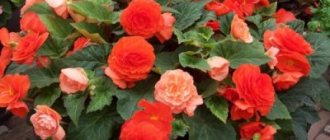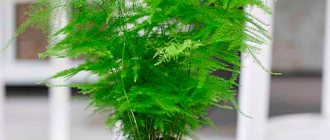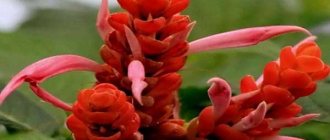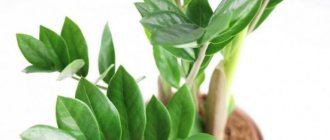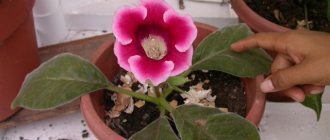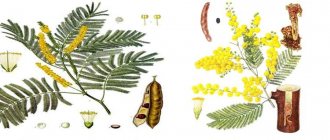- September 2, 2018
- garden plants
- Svetlana Funtova
Garden balsam is an unusually beautiful annual plant with a long flowering period. People call the flower “wet Vanka”, “light”, “touch-me-not”, “hurry”. Due to its raised flowers and relatively green mass, the plant is widely used in landscape design and to create flower beds, lawns, and alpine slides. In this article we will look at how to properly plant a flower in open ground, features of care and cultivation.
Description
The garden balsam flower (photos presented in the article) is a semi-shrub plant. Depending on the species, it can be annual or perennial. Strongly branched - its height, depending on the species, varies from 25 to 70 cm, in the wild - up to 2 meters. Stems are densely leafy, smooth. The leaves are 8-12 centimeters in length, alternately located on the branches of the plant, usually oval or oblong in shape with a pointed end or finely jagged edges, painted violet-bronze or green. During the growing season, small drops appear on the leaves, which gave the balsam its popular name “wet Vanka”.
In countries with year-round cultivation, the plant can bloom for up to 11 months, which is undoubtedly one of its main advantages. Depending on the variety, up to 50 flowers can bloom simultaneously on one balsam bush.
Types and varieties of garden balsam
There are about 500 species of balsam in nature, but only 15 are grown as garden plants, among which there are both annual and perennial plants.
Depending on the shape of the bush, impatiens are:
- bush;
- ampelous;
- erect.
Among the wide variety of varieties of garden balsams, there are both low-growing flowers and tall ones.
Waller's balsam
Impatiens forms a spherical bush with a height of 15 cm to half a meter. Its rhizome is powerful and rapidly developing. The leaves are glossy, wide, emerald in color, arranged alternately on the lower part of the stems, and oppositely at the top.
The flowers of Waller's balsam (Walleriana) are large, up to 5 cm in diameter. The color of the petals is varied - white, cream, scarlet, lilac and violet.

Impatiens 'Waller' continues to bloom throughout the season.
Balsam Carmelita
The annual plant has a pyramidal shape and a height of up to 75 cm. In open ground, growing garden balsam "Carmelita" is possible in shady areas of the garden. The flower needs positive air temperatures and sufficient soil moisture. The stems of the plant are thick, but fragile, and easily break at the nodes. The flowers are large, double, camellia-shaped with a variety of colors - from whitish to purple. Flowering continues all summer - from June to September.
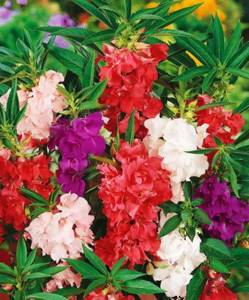
Balsam "Carmelita" can be grown in containers, flowerpots and on balconies
Balsam Tom Thumb
Variety “Tom Thumb” is a garden balsam with large double flowers. The height of the plant is small - up to 25 cm. The leaves are tender, densely covering the succulent stems. The variety is used to decorate gardens in places where there is a lack of sunlight. Used for borders, flower beds and ridges. Flowering lasts all season.
Read more Balsam Tom Samb (Tamb): growing from seeds at home, care

Pink "Tom Thumb" is the tallest in its series
Balsam Fashionista
The variety is classified as slightly bushy, but profusely flowering. The flowers of the garden balsam "Modnitsa" are double, pink, with small white spots. Their shape is camel-shaped. When grown in the garden, "Fashionista" balsam is pinched at the top to achieve a bushier form. It is used for growing in flower beds, in flowerpots and used for cutting.
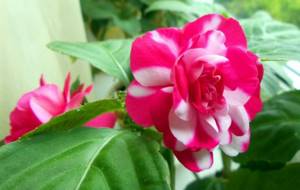
Sowing balsam seeds "Modnitsa" for seedlings begins 100 days before planting
Reproduction
The garden balsam flower is propagated by cuttings or by seed:
- The first method is suitable for growing at home or in open ground. Select the strongest shoot and cut it at an angle of 45°. The cut is treated with growth stimulants and placed in a vessel with water or pre-moistened soil. When the cutting takes root, it is transplanted into a small pot, the diameter of which is 10-12 cm. If you plant a spring cutting in the ground, the balsam will delight you with its flowering already in the same summer. A summer cutting that is planted will bloom in the fall and continue to bloom in the winter in the presence of warmth and light. An autumn seedling needs additional care, otherwise there is a risk of rotting of the root system.
- Seeds begin to be sown in early March; with the appearance of two balsam leaves, they are planted in different pots. Towards the end of May, plants can be planted in open ground.

Plant propagation
Seeds
Seeds are planted in open ground only after the soil has completely warmed up. When the risk of repeated frosts has passed, the planting material is placed in shallow holes (no more than 2 cm) and sprayed. Before emergence, it is important to provide sufficient watering, but without waterlogging. The next watering is carried out only after the top layer has dried. Emerging seedlings must be protected from direct sunlight. For this purpose, an artificial darkening is constructed. Seed germination is good, so thinning will be required.
Seedlings
Seeds for seedlings are sown at the end of February. The container should be shallow. The seeds are very small, so there is no need to deepen them into the soil. They are slowly distributed evenly on the surface of the earth and sprayed with a spray bottle. Water allows them to penetrate the substrate to the required depth. The containers are covered with glass or transparent film. They are stored in a greenhouse or in a room where the temperature does not exceed 15 degrees. Frequent spraying is carried out.
Shoots appear after 4 weeks. From this day on, hydration constantly decreases. Young plants need to be thinned out. As soon as one leaf appears on the seedling, you can plant each garden planting in a separate pot. For active growth, seedlings must be provided with regular moisture (spraying), sunlight and optimal temperature (13-15 degrees).
They are transferred to open ground at the end of April. Before this, the seedlings require hardening. She is taken out into the fresh air every day. Start with 5 minutes, increasing the time every day.
Growing conditions: soil, temperature, lighting
Impatiens cultivation and care largely depend on temperature conditions, area illumination and soil quality.
- For a plant to grow and develop well, it needs sufficient humidity and good lighting. Impatiens belong to light-loving flowers, but still the best growth and flowering indicators are shown by representatives grown in partial shade lighting. It has a bad effect on the plant, and sometimes leads to death when grown in the shade.
- The soil around the balsam needs to be loosened from time to time, but not too deep. In the off-season (once every 14 days), the flower needs to be fed. During the winter flowering period, feeding the plant is also necessary, but this can be done once a month.
- The optimal temperature for growing balsam in summer and spring is from 22 to 25 ° C, subject to regular watering of the substrate and ventilation of the room.
Caring for the “touchy”
All types of impatiens are sun-loving plants. In summer they are planted in open ground. Planting takes place no earlier than June so that the plant can acclimatize.
Advice. The best option for balsam in open ground is partial shade.
In winter, the perennial needs additional lighting. With its deficiency or absence, balsams stop blooming.
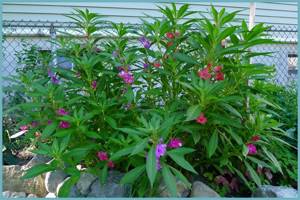
Impatiens are very thermophilic, so even in winter you need to maintain the optimal temperature.
The main problem in caring for a plant is the need to maintain temperature conditions. The optimal temperature for it in summer is from 18 to 25 degrees Celsius, in winter from 13 to 16. Frequent changes negatively affect the plant.
In summer, watering balsam should be plentiful, and in autumn-winter - infrequent. When watering, it is important to remember the balance: the plant should not be dry or too wet, as this leads to rotting of the roots.
Fertilizers are used exclusively in summer once every 14 days. In winter, the perennial is fertilized only if it blooms. In this case, mineral fertilizers are suitable.
Planting methods
On the territory of Russia, planting and caring for garden balsam is carried out only with the onset of a warm period. The plant is planted in open ground no earlier than the air temperature rises to 20 °C.
There are 2 planting methods:
- planting seedlings;
- sowing method.
The shelf life of garden balsam seeds is approximately 8 years; by purchasing them once, you can provide yourself with seedlings for several years. Better germination can be achieved after 3-4 years of storage.
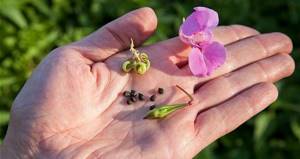
Garden balsam: planting and care in open ground
In early or mid-May, when the frosts have ended, Impatiens can be planted in open ground or in pots and flowerpots for outdoor decoration. It is important to remember that this flower is light-loving, but hot weather and bright sun all day long can weaken the plant, so the best option for Impatiens is partial shade. It is better to place pots and flower pots under canopies, canopies, and in the garden they should be planted along fences, under the crown of trees, shrubs, next to tall flowers, or on the side of the site where the sun does not shine all day.
The soil
Grown branchy bushes are no longer as picky about the soil as young shoots. The soil should be sufficiently fertile, non-acidic, and loose. Holes for planting seedlings are made according to the size of the earthen ball in glasses, so as not to deepen the root collar. You can pour a little dry vermicompost at the bottom of the holes. If a lump of earth taken out of a glass is completely stitched with white roots, it means that the bush has developed correctly and will take well to its new location. After planting, the bushes need to be watered well and the soil around them should be mulched. Mulch will protect the soil from drying out, maintain good aeration of the roots, and retard the growth of weeds.
Tip - to determine the acidity of the soil, you can brew several currant leaves with boiling water and infuse them. If, when adding a little earth to the infusion, it becomes reddish in color, it means the soil is acidic, a blue solution indicates that the soil is slightly acidic, and a green solution means the soil is neutral.
Watering
Impatiens are a moisture-loving plant; from a lack of moisture, the leaves become dull, curl, and flowers fall off, but excess moisture in the soil can lead to fungal diseases. Therefore, daily watering is only needed on hot summer days. The soil should be moist to a depth of 30-40 cm, no more. Flowers in pots are watered into trays. For irrigation, it is advisable to use rainwater or settled water warmed in the sun.
Top dressing
Abundant, continuous flowering over a long period of time requires regular feeding of the soil with fertilizers. Fertilizing needs to be done every 2-3 weeks. It is important to remember that nitrogen fertilizers stimulate the growth of green mass of the plant, potassium improves the decorative properties of flowers, and phosphorus strengthens the root system. By the appearance of the bushes you can determine what the flowers are missing. As practice shows, complex fertilizers support the plant well; the main thing is not to overuse nitrogen fertilizers, otherwise there will be more leaves than flowers.
Advice - in order for the Balsam to bloom magnificently, abundantly, and for a long time, it is recommended to regularly pluck off old flowers and the tops of the stems. This will enhance the branching of the bush and the formation of a large number of flower stalks.
Breeding Balsam is a simple and not labor-intensive process. By following the recommendations outlined correctly and in a timely manner, growing these flowers will become exciting and interesting for you. Impatiens is an unpretentious, responsive and grateful flower. It can be grown as an annual or perennial, at home or in open ground. It does not have a dormant period, so it can bloom for a whole year. And there is only one drawback - an incredible number of varieties and colors, your eyes run wild, it’s difficult to make a choice.
marked ,
Your opinion is very important to us. Please rate the article: There are no ratings yet. Please rate
See also related articles
Begonia everblooming: garden care
Add a comment Cancel reply
You must be logged in to post a comment.
✿ Alphabetical index
✿ Categories
- Houseplants
- Bromeliads
- Decorative foliage
- Trees and shrubs
- Orchids
- Succulents
- Blooming
- Perennial
✿ Popular articles
- How to grow chestnut from a nut at home in a pot
- Clematis: care and cultivation in the garden
- How to grow pomegranate from seeds at home to produce fruits
- How to grow lemon from a seed at home with fruits: step by step
- Decembrist flower: care at home, how to water correctly
- Hedera "Helix mix": home care
✿ Latest comments
- Lyudmila on How to grow a lemon from a seed at home with fruits: step by step
- Tatyana on Tillandsia Anita: care at home
- LOVE for the entry Tulips: care and cultivation in the garden
Copyright © 2018-2021 GARDENER'S BOOK.
0+ By using bookgardener.ru you accept the terms of the USER AGREEMENT. Copyright for the posted materials belongs to the editors of the online magazine. When reprinting and using materials, an active hyperlink to BookGardener.ru is required
How to prepare seeds for planting?
Garden balsam seeds (photos of which are presented in the article) require careful care and proper preparation.
First of all, the seeds must be disinfected in a bright solution of potassium manganese or other liquid with disinfectant properties available on hand. The seeds are soaked in the solution for 15 minutes, then placed on a damp cloth to swell.
Several seeds are dropped into prepared, moistened holes and sprinkled with soil. The top of the soil is lightly sprayed and covered with cellophane. Under no circumstances should the soil be allowed to dry out or the temperature drop below 20 °C. After 1-1.5 weeks, when shoots appear, the film can be removed. In case of dense sowing, seedlings are pruned or thinned.
Preparing the soil and container
When growing garden balsam at home, the plant should be provided with loose soil. Excessively enriched soil composition contributes to the rapid development of green mass to the detriment of flowering.
The most optimal soil for a flower is an even ratio of turf, compost and humus, or peat and sand in equal proportions and their double portion of leaf soil. Seedlings do not tolerate organic fertilizers.
It is best to grow balsam in separate containers or medium-sized pots with drainage holes. It’s good if the size of the container is only a few centimeters larger than the sprout.

Floral arrangements or combinations with plants
Gardeners prefer to plant balsam in group plantings. It goes great with begonias and bluebells. Some people like the composition of balsam with violets. Balsam looks interesting in company with boxwood.
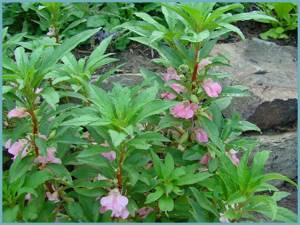
Impatiens in the rock garden
“Vanka wet” has become widespread in landscape design. It is used to decorate alpine slides and flower beds. Garden balsam is also used to decorate borders and create mixboxers.
Garden balsam is an annual plant that, with careful care, can become a perennial plant. It can be grown both at home and in open ground. Planting, propagating and caring for a plant may seem quite difficult for some. But the beauty of the annual and its fabulous flowers-lights compensate for everything in full.
Sowing
Planting garden balsam in a container is carried out in several stages:
- The soil in the prepared container is thoroughly loosened and leveled, then the surface is moistened with settled water at room temperature. Seeds are placed on top.
- If sowing is done in separate pots, then no more than three seeds are placed in each. When planting in a large container, the seeds are laid out according to the principle of a square - 4 by 4 cm.
- For better germination, seeds require good lighting, so they are left on the surface of the ground or lightly dusted with sand.
- After this, the soil is moistened again and covered with a transparent film or other transparent cover.
- Containers with seeds are placed in a well-lit and warm place. Direct rays of the sun can be destructive to seeds, so it is better if the light is diffused.
- Every day the soil must be moistened and the room ventilated for 3-5 minutes.
- The air temperature should not be lower than 20 °C.
If the outcome is successful, the first shoots will appear in 7-10 days.
Growing conditions
Impatiens thrive in shade: under apple trees or bushes. In the sun, their flowers fade and turn pale, but in the shade the color is more saturated.
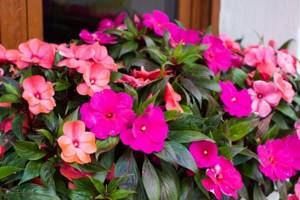
They ideally grow on the shady side of the house, near the fence, and also perfectly decorate unsightly structures where other crops do not bloom without light.
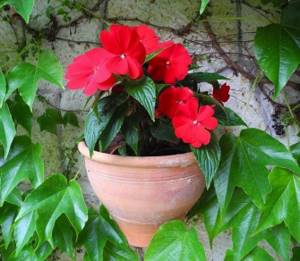
Advice. When planting in open ground, choose quiet corners of the estate, protected from drafts and winds. This is due to the tenderness and fragility of the stems, which break easily.
Caring for seedlings and when to plant them in the ground?
As the seedlings develop, the care of garden balsam changes, but this is done in stages. First, the duration of ventilation is increased, then small holes are made in the covering film and only then it is completely removed.
Now you can start hardening the seedlings. Every day the air temperature is reduced by one degree to 16 °C, while watering and lighting are not changed. Thinning or picking is carried out after the appearance of two full leaves. After this, the frequency of watering can be reduced.
4-5 weeks after planting the balsam, the seedlings are accustomed to the open air. For the first two days, the sprouts are left outside for a couple of hours, extending the residence time every day. As a result, after a week the seedlings remain in the air all day.
Young plants have not yet become strong, so pots with sprouts are protected from exposure to sun and wind. Watering is carried out in the evening, when the seedlings are brought home. The water should be at room temperature or a few degrees warmer.
As a rule, plants are transplanted into open ground in the last ten days of May, when warm weather sets in. The sprouts are transplanted with their own lump of earth at a distance of 25 to 50 cm, depending on the type of balsam.

Planting and care
Selection and preparation of soil

Touch-me-not is an unpretentious culture. Almost any soil is suitable for it, as long as its acidity level does not exceed 6 pH units . A substrate is also made for balsam. To do this, mix turf soil, sand, humus and leaf soil in equal parts. The root system is powerful; a good drainage layer is indispensable.
Caring for the plant is simple. Even a novice gardener with absolutely no experience can cope with them.
Watering and temperature conditions
Watering is the most important requirement in caring for balsam. The splendor and duration of flowering depend on moisture. If the leaves begin to wither, this is a clear sign of lack of moisture. Water it daily . On particularly hot days in the morning and evening. Settled water at room temperature is best. Pour it under the bush; do not spray the leaves and flowers.
The homeland of impatiens is Africa, so heat and open sun rays do not frighten the plant. It can withstand temperatures up to 30 degrees without compromising decorativeness. But in this case, artificial darkening from direct rays is constructed. They promote the evaporation of much-needed moisture. If you grow wet vanilla in a pot, then for winter flowering you need a temperature of at least 18 degrees.
Diseases and pests
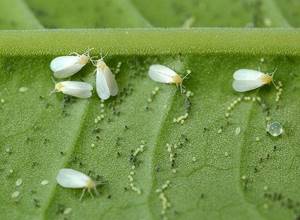
Whitefly can significantly damage a flower. If a pest is detected, immediately treat the plant with chemicals.
The most dangerous enemies of balsam are spider mites and whiteflies . When they infect a bush, they cause lethargy, paleness and leaf drop. To combat them, special chemicals are used. And as a preventative measure, the garden planting is treated with a soap solution.
Feeding
With a lack of nutrients and minerals, flowering becomes poor, leaves turn yellow or fall off. Feeding is carried out from the beginning to the end of flowering. Use complex mixtures once every 2 weeks.
Trimming
For a more decorative formation of buds, the tops of the shoot are plucked off as soon as the height of the stem reaches the required size. This has a beneficial effect on the growth and flowering of other buds. A large number of them provide the bush with splendor, volume and long flowering. It will not be superfluous to carry out sanitary pruning. Old, dried or yellowed leaves and shoots are removed.
Site selection and soil preparation
For proper care and planting of garden balsam (a photo of the plant is presented in the article), the growing location and soil play a significant role.
The ideal site for the plant would be a place protected from the winds, with diffused sunlight. Impatiens is a heat-loving plant, so sharp temperature fluctuations are destructive for it, as are scorching sun rays, which negatively affect the growth and development of the flower. Flower beds and flower beds with balsam are best planted along the house, gazebo or near trees.
The soil for the plant must be prepared in advance, so balsam planted in heavy soil with close groundwater develops poorly, its leaves become smaller, and its flowering is poor.
You can avoid this if:
- if moisture stagnates, provide the root system of the flower with drainage from sand, crushed stone, stone or other available materials;
- loosen heavy clay soil with humus, sand, perlite or other appropriate material;
- ensure the appropriate PH level of the soil; if it is overly acidic, flavor it with limestone and dig it up;
- maintain a nutritional balance; if humus was used to loosen the soil, no additional fertilizers are applied.
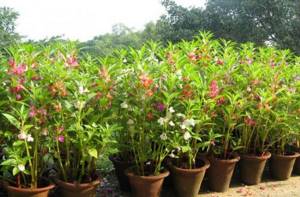
Caring for an adult plant
Impatiens is not a demanding plant; it requires timely watering and systematic feeding.
The nuances of planting garden balsam and caring for it (photo below):
- Water the bush abundantly, at the root. It is advisable that water does not fall on the flowers during watering. On hot days, balsam leaves are sprayed twice a day - morning and evening. The soil around the plant is loosened superficially 2-3 times a week.
- Water for irrigation should be rain, river or settled water, approximately the same temperature as the air. If, over time, a white deposit of salt and lime has formed on the soil, it is carefully removed and replaced with earth of a similar composition.
- In the case of balsams, foliar feeding is highly not recommended. Fertilize plants by root method in small doses, once every two weeks until September.
- At the beginning of budding, the flower is fed with mineral fertilizers containing phosphorus and potassium. Nitrogen-based fertilizers are prohibited during this period.
- As a rule, the plant is not susceptible to attack by pests; if this cannot be avoided, the balsam is treated with an appropriate insecticide.
- Fungal diseases are also not characteristic of balsam, but it can be infected by watering too frequently and abundantly. If the root system is damaged by a fungus, the infected parts are removed, the remaining parts are treated with antifungal drugs. Watering frequency is reduced.
Plant nutrition
The garden balsam flower, a photo of which is presented in the article, begins to be fed three weeks after planting. Complex mineral fertilizers are best suited for this. If you feed the plant too often, the bush will begin to shed its leaves and bloom worse. Therefore, it is recommended to use only half the required dose of fertilizer or halve its concentration.
Feed balsam 2 times a month after watering. Sick and weakened plants should not be fertilized.
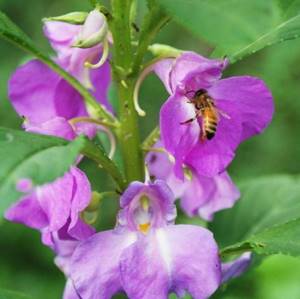
Growing Tips
In order for garden balsam to sprout on time, grow well and not get sick, it is necessary to take into account some nuances of growing the plant:
- The flower prefers slightly acidic soil.
- If you plan to grow the plant in a pot, you need to organize a 3 cm drainage layer of fine crushed stone at the bottom.
- If the air temperature at night is below 10 °C, it is better to wait to plant the plant in open ground, otherwise it will most likely die.
- Impatiens growing in the shade bloom sparingly and grow very elongated; 10-12 hours of daylight is considered ideal for it.
- The soil around the plant should not be allowed to dry out; the flower will slow down its growth and the flowers will begin to fall off.
- The quality of the cuttings is affected by the frequency of pruning the main stem.
- To spray balsam, it is recommended to choose a sprayer with the smallest drops.
- Garden balsam is successfully combined in joint plantings with such plants as: fuchsia, begonia, petunia,
There are more than 500 varieties of balsam (ferruginous, creeping, small-flowered, Waller's balsam, etc.), each variety is characterized by an individual shape and color. Due to its unpretentiousness and bright flowering, it is often used to decorate parks, flower beds and home areas.
Planting balsam
Planting can be done both in a pot and in open ground. It is carried out mainly by seeds. Although you can buy an already mature plant.
Advice. Impatiens prefer slightly acidic soil, so add peat moss before planting in the pot.
The plant's germination rate is high quality. Planting is carried out one seed at a time in a separate pot.

It is better to first grow plants in a pot, and only then transplant them into open ground.
- The plant must be kept at home for 3 weeks after planting.
- After sprouting, the balsam should be moved to a cool place, for example, to a loggia.
- When the plant reaches 5 cm in height, it should be transplanted into a separate pot or open ground.
- The root should be plucked off a little. This is done to stimulate root development.
- Balsam is planted in shallow holes, lightly pressing the soil.
- Loosen the soil around the plant. In order for the plant to be lush and grow better, the crown should be trimmed.
